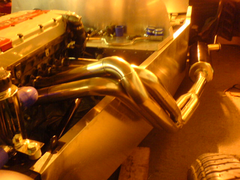
TIG Basics
Alan B - 5/3/07 at 05:34 PM
Hi Guys,
I decided it's about time I actually got some use out of my TIG welder.
I have done a very small amount before, but I can remember little so consider me completely new.
Questions:
I will be welding almost entirely low carbon steels so what gas should I get?
If I could stainless or ally too that would nice but low carbon is the priority.
I will be starting off welding 1/8 wall round tube so what would be a good starting point settings wise?
Or would I be better practicing on thinner stuff like 16g or so?
I guess that will do for now....yes I know there plenty of books, and I have many, but nothing beats the wise words from fellow builders..
Cheers,
Alan
Peteff - 5/3/07 at 05:49 PM
for everything you need from what I can remember.
kikiturbo - 5/3/07 at 06:08 PM
go to the miller welding site and download the TIG book, it is everything you need...
http://www.millerwelds.com/education/TIGhandbook/
cheers
vlado
nitram38 - 5/3/07 at 06:55 PM
Alan I will show you if you can put me and my family up for a fortnight!
I love Florida.....been 4 times since 96!
Martin
Alan B - 5/3/07 at 07:08 PM
How big is your family?.....seriously, we may have a deal here...
nitram38 - 5/3/07 at 07:32 PM
About 95 
Only 4 immediate family 
Simon - 5/3/07 at 07:41 PM
Alan,
Before you start, and if your machine has the capability, get yourself a footpedal amp control.
I don't know how people manage without them
ATB
Simon
907 - 5/3/07 at 09:50 PM
quote:
Originally posted by Alan B
Hi Guys,
Questions:
I will be starting off welding 1/8 wall round tube so what would be a good starting point settings wise?
Cheers,
Alan
Hi Alan,
A butt weld in 3mm wall assuming bevelled edges would be 60 ish for the root run, 75 ish for the cap.
The fillet part of a tee might be 85/90 and a 5mm thick flange welded to the end of a tube 110 ish.
You should start off using low settings and as you become more practiced you will find you can cope
with higher settings and faster speed of travel.
I personally wouldn't advise a foot pedal to start with as it is easier to reproduce a weld if you have a set amperage.
By all means move onto one as your knowledge of what to look for increases.
IMHO there is no substitute for one on one personal tuition.
The gas used is pure argon.
Good luck
Paul G
[Edited on 7/3/07 by 907]
Simon - 5/3/07 at 10:51 PM
quote:
Originally posted by 907
IMHO there is no substitute for one on one personal tuition.
Paul G
And practice
ATB
Simon
bartonp - 6/3/07 at 04:32 PM
3mm? That's arc (stick) welder territory!
JB - 6/3/07 at 05:49 PM
I find thicker steels easier to weld, ie 2 to 3mm. If you are doing a butt weld and the two pieces of metal are touching you should be able to melt
the two together if you have the setting correct.
I learnt to gas weld and then moved to TIG. With Tig the rod is more parrallel to the work and dips into the weld pool. If you get the setting just
right you move the torch closer when the rod is dipped into the weld pool.
If you weld stainless ideally you want gas on both sides of the weld.
For aluminium you need an AC machine and I think a different gas.
flak monkey - 6/3/07 at 05:54 PM
Argon for everything on TIG. You can use argon/co2 mix for mild steel though.
16g is a good starting place, fairly easy to do, and not too easy to blow holes in. Start with a lower amperage too, you can just move the torch
slower to increase the weld pool size to a good size, and get good penetration. As you get better you can increase the amps and speed.
Practice, practice, practice
David
NS Dev - 6/3/07 at 07:23 PM
Basically just get scrap and play. This was my first TIG project (sorry to those who have seen the pics a million times!! ), I welded 3 bits if
stainless beforehand to get the idea, and I have done very little gas welding in the past, but TIG on steel is not difficult, apart from me getting
through lots of tungsten through being clumsy and cack handed, and having hopelessly unsteady hands for some strange reason...............


exhaust 4
CairB - 7/3/07 at 12:49 PM
NS Dev,
Did you back purge when you welded it?
I'm just about to start mine and have found it makes a big difference to the weld quality on the other side.
Cheers,
Colin
[Edited on 7/3/07 by CairB]
ScotJebus - 7/3/07 at 10:12 PM
well the tig machines that they use at college are run on argon, and they wouldnt use that unless they really felt it best to use it and nearly all
the tig done is on 3mm mild steel with the odd bits of ally, so id say stick with pure argon for the gas.




